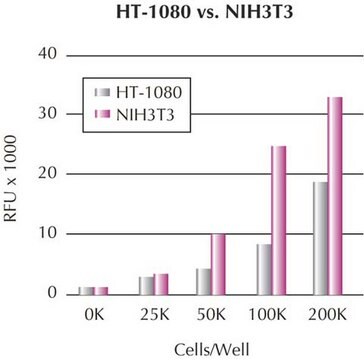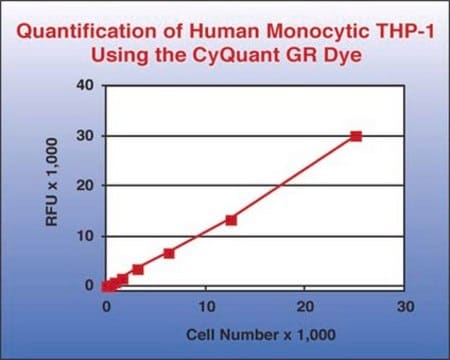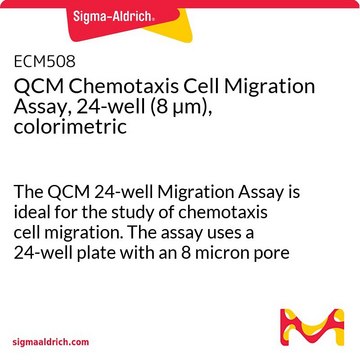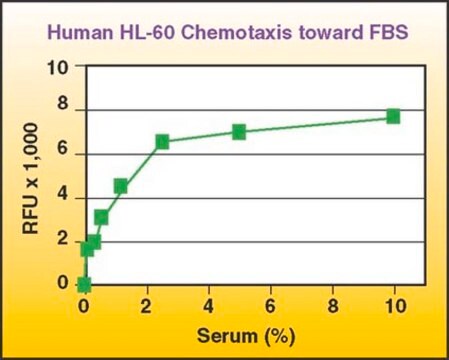おすすめの製品
品質水準
交差性(ホモロジーによる予測)
all
メーカー/製品名
Chemicon®
QCM
テクニック
activity assay: suitable
cell based assay: suitable
検出方法
fluorometric
輸送温度
wet ice
詳細
Also available: Cell Comb™ Scratch Assay! Get biochemical data from a scratch assay!
Click Here
Introduction
Cell migration is a fundamental function of normal cellular processes, including embryonic development, angiogenesis, wound healing, immune response, and inflammation. Microporous membrane inserts are widely used for cell migration and invasion assays. The most widely accepted of which is the Boyden Chamber assay. However, current methods of analysis are time-consuming and tedious, involving cotton swabbing of non-migrated cells on the top side of insert, manual staining and counting. Recently a fluorescence blocking membrane insert was introduced to address these issues; however, this approach requires labeling of the cells with Calcein-AM and extensive washing to remove free Calcein before cell migration. The effect of this treatment on cell behavior/migration remains questionable.
The Chemicon QCM<TMSYMBOL></TMSYMBOL> 96-well Migration Assay does not require cell labeling, scraping, washing or counting. The 96-well insert and homogenous fluorescence detection format allows for large-scale screening and quantitative comparison of multiple samples.
In the Chemicon QCM<TMSYMBOL></TMSYMBOL> 96-well Migration Assay, migratory cells on the bottom of the insert membrane are dissociated from the membrane when incubated with Cell Detachment Buffer. These cells are subsequently lysed and detected by the patented CyQuant GR dye (Molecular Probes). This green-fluorescent dye exhibits strong fluorescence enhancement when bound to cellular nucleic acids.
The Chemicon QCM<TMSYMBOL></TMSYMBOL> 96-well Migration Assay provides a quick and efficient system for quantitative determination of various factors on cell migration, including screening of pharmacological agents, evaluation of integrins or other adhesion receptors responsible for cell migration, or analysis of gene function in transfected cells.
The Chemicon QCM<TMSYMBOL></TMSYMBOL> 96-well Migration Assay utilizes an 8 μm pore size, as this is appropriate for most cell types. This pore size supports optimal migration for most epithelial and fibroblast cells; however, it is not appropriate for lymphocyte migration experiments. The system may be adapted to study different types of cell migration, including haptotaxis, random migration, chemokinesis, and chemotaxis.
In addition, Chemicon also provides QCM<TMSYMBOL></TMSYMBOL> 24-well insert cell migration assay systems, CytoMatrix<TMSYMBOL></TMSYMBOL> Cell Adhesion strips coated with ECM proteins or anti integrin antibodies, and QuantiMatrix<TMSYMBOL></TMSYMBOL> ECM protein ELISA kits.
Application:
The Chemicon QCM<TMSYMBOL></TMSYMBOL> 96-well Migration Assay is ideal for the study of chemotaxis cell migration. The quantitative nature of this assay is especially useful for large scale screening of pharmacological agents. The 8 μm pore size of this assay′s Boyden chambers is appropriate for migration studies of most cell types. Each kit provides sufficient materials for the evaluation of 96 samples.
The Chemicon QCM<TMSYMBOL></TMSYMBOL> 96-well Migration Assay is intended for research use only; not for diagnostic applications.
Click Here
Introduction
Cell migration is a fundamental function of normal cellular processes, including embryonic development, angiogenesis, wound healing, immune response, and inflammation. Microporous membrane inserts are widely used for cell migration and invasion assays. The most widely accepted of which is the Boyden Chamber assay. However, current methods of analysis are time-consuming and tedious, involving cotton swabbing of non-migrated cells on the top side of insert, manual staining and counting. Recently a fluorescence blocking membrane insert was introduced to address these issues; however, this approach requires labeling of the cells with Calcein-AM and extensive washing to remove free Calcein before cell migration. The effect of this treatment on cell behavior/migration remains questionable.
The Chemicon QCM<TMSYMBOL></TMSYMBOL> 96-well Migration Assay does not require cell labeling, scraping, washing or counting. The 96-well insert and homogenous fluorescence detection format allows for large-scale screening and quantitative comparison of multiple samples.
In the Chemicon QCM<TMSYMBOL></TMSYMBOL> 96-well Migration Assay, migratory cells on the bottom of the insert membrane are dissociated from the membrane when incubated with Cell Detachment Buffer. These cells are subsequently lysed and detected by the patented CyQuant GR dye (Molecular Probes). This green-fluorescent dye exhibits strong fluorescence enhancement when bound to cellular nucleic acids.
The Chemicon QCM<TMSYMBOL></TMSYMBOL> 96-well Migration Assay provides a quick and efficient system for quantitative determination of various factors on cell migration, including screening of pharmacological agents, evaluation of integrins or other adhesion receptors responsible for cell migration, or analysis of gene function in transfected cells.
The Chemicon QCM<TMSYMBOL></TMSYMBOL> 96-well Migration Assay utilizes an 8 μm pore size, as this is appropriate for most cell types. This pore size supports optimal migration for most epithelial and fibroblast cells; however, it is not appropriate for lymphocyte migration experiments. The system may be adapted to study different types of cell migration, including haptotaxis, random migration, chemokinesis, and chemotaxis.
In addition, Chemicon also provides QCM<TMSYMBOL></TMSYMBOL> 24-well insert cell migration assay systems, CytoMatrix<TMSYMBOL></TMSYMBOL> Cell Adhesion strips coated with ECM proteins or anti integrin antibodies, and QuantiMatrix<TMSYMBOL></TMSYMBOL> ECM protein ELISA kits.
Application:
The Chemicon QCM<TMSYMBOL></TMSYMBOL> 96-well Migration Assay is ideal for the study of chemotaxis cell migration. The quantitative nature of this assay is especially useful for large scale screening of pharmacological agents. The 8 μm pore size of this assay′s Boyden chambers is appropriate for migration studies of most cell types. Each kit provides sufficient materials for the evaluation of 96 samples.
The Chemicon QCM<TMSYMBOL></TMSYMBOL> 96-well Migration Assay is intended for research use only; not for diagnostic applications.
アプリケーション
QCM 8 uM 96ウェル遊走アッセイは、白血球の遊走に適している8 umの孔径を使用しています。
研究のカテゴリ
細胞構造
細胞構造
包装
96ウェル
構成
滅菌96ウェル細胞遊走プレートアセンブリ:(部品番号:90128)96ウェルフィーダートレイ1枚、および96ウェル細胞遊走チャンバープレート1枚。面積=0.3 cm2、細胞50,000個/ウェル
96ウェル細胞培養トレイ:(部品番号:90129)96ウェルフィーダートレイ1枚。
細胞接着溶液:(部品番号:90131)16 mLボトル 1本。
4倍濃縮細胞溶解緩衝液:(部品番号:90130) 16 mLボトル1本。
CyQuant GR Dye:(部品番号:90132)75 μLバイアル1本
96ウェル細胞培養トレイ:(部品番号:90129)96ウェルフィーダートレイ1枚。
細胞接着溶液:(部品番号:90131)16 mLボトル 1本。
4倍濃縮細胞溶解緩衝液:(部品番号:90130) 16 mLボトル1本。
CyQuant GR Dye:(部品番号:90132)75 μLバイアル1本
法的情報
CELL COMB is a trademark of Merck KGaA, Darmstadt, Germany
CHEMICON is a registered trademark of Merck KGaA, Darmstadt, Germany
免責事項
メルクのカタログまたは製品に添付されたメルクのその他の文書に記載されていない場合、メルクの製品は研究用途のみを目的としているため、他のいかなる目的にも使用することはできません。このような目的としては、未承認の商業用途、in vitroの診断用途、ex vivoあるいはin vivoの治療用途、またはヒトあるいは動物へのあらゆる種類の消費あるいは適用などがありますが、これらに限定されません。
シグナルワード
Danger
危険有害性情報
危険有害性の分類
Aquatic Acute 1 - Aquatic Chronic 2 - Eye Dam. 1
保管分類コード
10 - Combustible liquids
適用法令
試験研究用途を考慮した関連法令を主に挙げております。化学物質以外については、一部の情報のみ提供しています。 製品を安全かつ合法的に使用することは、使用者の義務です。最新情報により修正される場合があります。WEBの反映には時間を要することがあるため、適宜SDSをご参照ください。
毒物及び劇物取締法
キットコンポーネントの情報を参照してください
PRTR
キットコンポーネントの情報を参照してください
消防法
キットコンポーネントの情報を参照してください
労働安全衛生法名称等を表示すべき危険物及び有害物
キットコンポーネントの情報を参照してください
労働安全衛生法名称等を通知すべき危険物及び有害物
キットコンポーネントの情報を参照してください
カルタヘナ法
キットコンポーネントの情報を参照してください
Jan Code
キットコンポーネントの情報を参照してください
試験成績書(COA)
製品のロット番号・バッチ番号を入力して、試験成績書(COA) を検索できます。ロット番号・バッチ番号は、製品ラベルに「Lot」または「Batch」に続いて記載されています。
Zhaolu Wang et al.
Journal of cerebral blood flow and metabolism : official journal of the International Society of Cerebral Blood Flow and Metabolism, 32(2), 387-398 (2011-11-03)
Ischemic stroke affecting the adult brain causes increased progenitor proliferation in the subventricular zone (SVZ) and generation of neuroblasts, which migrate into the damaged striatum and differentiate to mature neurons. Meteorin (METRN), a newly discovered neurotrophic factor, is highly expressed
Nadia K Guimaraes-Souza et al.
Nephrology, dialysis, transplantation : official publication of the European Dialysis and Transplant Association - European Renal Association, 27(8), 3082-3090 (2012-01-31)
Recent advances in cell therapies have provided potential opportunities for the treatment of chronic kidney diseases (CKDs). We investigated whether human kidney structures could be preformed in vitro for subsequent implantation in vivo to maximize tissue-forming efficiency. Human renal cells
Rishipal R Bansode et al.
International journal of biological sciences, 7(5), 629-644 (2011-06-08)
The activity of N-hexanoyl-D-erythro-sphingosine, a C6-ceramide against angiogenesis was tested in vitro and in vivo. The effect of ceramide in inhibiting MCF-7 cancer cells was also determined. The aim of this study was to potentiate the effect of ceramide as
Hiroki Ono et al.
Arteriosclerosis, thrombosis, and vascular biology, 24(9), 1634-1639 (2004-07-10)
Migration of vascular smooth muscle cells (VSMCs) contributes to formation of vascular stenotic lesions such as atherosclerosis and restenosis after angioplasty. Previous studies have demonstrated that tumor necrosis factor-alpha (TNF-alpha) is a potent migration factor for VSMCs. cAMP-response element-binding protein
Janette M Birmingham et al.
Carcinogenesis, 30(4), 690-697 (2009-02-18)
Adipose tissue secretes factors linked to colon cancer risk including leptin. A hallmark of cancer is sustained angiogenesis. While leptin promotes angiogenesis in adipose tissue, it is unknown whether leptin can induce epithelial cells to produce factors that may drive
ライフサイエンス、有機合成、材料科学、クロマトグラフィー、分析など、あらゆる分野の研究に経験のあるメンバーがおります。.
製品に関するお問い合わせはこちら(テクニカルサービス)










